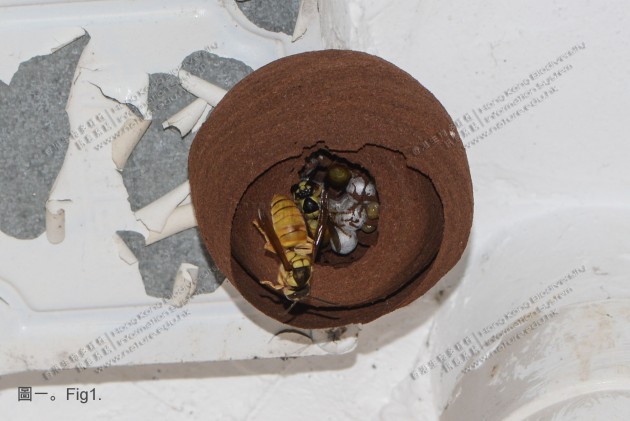雙色胡蜂 Vespa bicolor
31-07-2015
去年四月,可觀自然教育中心迎來一批新的住客 --雙色胡蜂。並見證著一幕又一幕由築巢至蜂群被殲滅至末落的過程。
雙色胡蜂
在大自然,我們不難發現以群體同巢生活的社會性昆蟲,雙色胡蜂亦是其中一種真社會性的蜂群。雙色胡蜂為小型胡蜂,其體型呈鮮豔的黃色,中胸背板黑色,造成明顯的黑色三角形,翅膀大致透明,其外形特徵教人極易辨認。在本地屬於常見的蜂類。
築巢
雙色胡蜂的巢穴築於樓梯轉角位置。剛發現時,蜂巢處於小形初期巢的階段。初期的巢呈圓形,巢內蛹繭仍清晰可見(圖一)。在第一批工蜂未曾破蛹而出前,擴大蜂巢的工作由蜂后一手包辦。圓中顯示,蜂后正在建構第二層外殼(圖二)。
擴巢
短短半個月的時間,擴展中的蜂巢已層次分明(圖三)。雙色胡蜂以木質物體(如樹幹的樹皮,枯木,人造的木質建築物)或其他植物纖維(如草支的細毛),經啃咬後與唾液混和成一種紙質的材料築巢,一層層的鋪陳在巢穴表面,此物質構成的蜂巢特性較輕又堅固。
五個月後,蜂巢已經成熟,規模亦較初期巢穴大數倍(圖四)。正值此時,雙色胡蜂胡蜂蜂巢亦將陷入巨大的危機。
侵略
在十月後旬,胡蜂蜂巢來了一名不速之客——黑尾胡蜂(圖五)。黑尾胡蜂專捕食其他社會性蜂類的幼體,它開始突襲雙色胡蜂的巢穴。
殲滅
黑色胡蜂深入雙色胡蜂的巢穴,並將雙色胡蜂蛹當為食糧,逐一啃吃。圖中,黑色胡蜂正在捕食雙色胡蜂蛹(圖六)。 面對黑尾胡蜂的強勢攻擊,巢內沒有反抗能力的雙色胡蜂難逃死亡的命運,無一倖免(圖七)。
Last April , Ho Koon Natural Education Center welcomed a new batch of resident-- Vespa bicolor. We witnessed the process from the build up to the wipe out of this community.
Vespa bicolor
In our mother nature, it is not hard to spot social insects that cooperates in groups and lives in the same nest.Vespa bicolor is a species of social wasp, they are the smallest local hornet. Ground colour bright yellow , with the dorsal surface of the mesonotum (central part of the thorax) black, forming a black triangular area while their wings are clear and thinner than other hornets. It can be easily recognized due to the lack of similar species locally. It is probably the most common local hornet.
Nest building
The Vespa bicolor nest was built right around the corner of the staircase. When we first discovered it , it was small at the embryo nest phrase. The embryo nest was round and the pupal cocoon caps were clearly observable (Fig 1). The nest was found by a single queen before the worker population grows and take over her job of nest expansion. As shown in the picture, the queen was completing the second layer of envelope (Fig 2).
Nest Expansion
In merely half a month's time, distinct layering of the nest could be seen (Fig 3).Vespa bicolor are built from wooden material from sources such as tree bark, rotten wood or man-made wooden stuctures , or from other plant fibres such as that found on the side of the grass stems. The wasp a small load of this material, and chews it, mixing it with her saliva, forming a paste that is applied in layers and dries into a papery pulp. The nest built from this material is light , yet solid.
Five months later, the nest expansion process completed, the mature nest was several times greater than the original embryo nest (Fig 4). Meanwhile , the fate of the nest was hung in the balance.
Invasion
In late October , an intruder-- Vespa ducalis invaded the nest (Fig 5). This gate-crasher is a specialist predator on offspring of other social wasps, it soon began the raiding of the nest.
Annihilation
The Vespa ducalis prey on the developing pupae of Vespa bicolor (Fig 6). Under the furious attack of Vespa ducalis, the vulnerable and defenseless pupae were killed one by one, not even a single of them were spared (Fig 7). This nest of Vespa bicolor died out.














